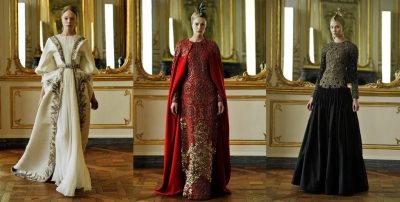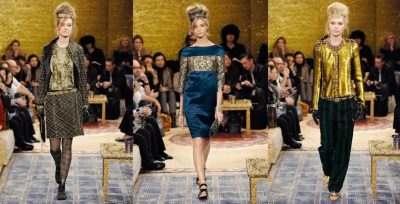
Dolce & Gabbana, FW 2013 RTW collection, backstage photo. Pinterest.
DailyArt Magazine: Have you ever wondered how Byzantine art stepped onto the catwalk? It all started with Empress Theodora and a Byzantine-inspired piece of jewelry from the 1930s – the Ravenna cuff owned by Coco Chanel. The great mosaics of the Byzantine Empire were a source of inspiration throughout the centuries for many artists and creators (Gustav Klimt’s golden paintings are the most obvious example of such inspiration). Let’s see what happens when Byzantine art meets high fashion, shall we?

Left: Coco Chanel wearing a cuff bracelet designed by Fulco di Verdura. Photo by Lipnitzki/Roger Viollet; Right: Fulco di Verdura, a silver, enamel, and simulated gemstone bracelet, private collection. Christie’s.
…
1. Alexander McQueen
Fall 2010 Ready-to-Wear
In the fall of 2010, Alexander McQueen presented what turned out to be his last collection, inspired by the Middle Ages. In this collection, among dresses inspired by Hieronymus Bosch’s paintings, we find Byzantine-inspired long gowns – bejeweled and embroidered with gold (some of them also with a floor-length cape inspired by a paludamentum) – truly worthy of an empress.

2. Chanel
Pre-Fall 2011 “Paris-Byzance”
“Coco Chanel is the new Theodora” said Karl Lagerfeld, the creative director of the fashion house Chanel, when he introduced the Pre-Fall 2011 collection inspired by the Byzantine Empress.
“Theodora was a circus artist who became an empress, like Chanel, who was a little singer and became a fashion empress.”
Karl Lagerfeld (attr.)

Chanel, Pre-Fall 2011 collection. Chanel’s website.
…
Rich colors, contrasted with gold, colorful gems, and mosaic embroidery reminds us of Byzantine splendor. This elegant collection is a tribute to Coco Chanel, who initiated the trend of Byzantine influence in modern fashion.

The resemblance to the Empresses Theodora and Irene can be seen in the model’s hair pinned up high, with tiara-like headbands and jewelry.

Chanel, Pre-Fall 2011 collection. Chanel’s website.
…
3. Dolce & Gabbana
Fall/Winter 2013 Ready-to-Wear
For me personally, the most memorable fashion show inspired by Byzantine art is Dolce & Gabbana FW 2013. Take a look at those stunning golden mosaics from Sicily printed on the clothes, embroidered dresses decorated with cabochons and gems!

Dolce & Gabbana, FW 2013 RTW collection. Photos by Filippo Fior.
n their ready-to-wear collection, Domenico Dolce and Stefano Gabbana represented mosaics from the Santa Maria Nuova Cathedral constructed in the late 12th and 13th centuries. They had 6,340 square meters of tesserae mosaics to choose from as their inspiration! (As some of you might know, Monreale cathedral’s mosaic decoration is the largest mosaic decoration in Italy).

Dolce & Gabbana, Fall/Winter 2013 RTW collection. Photos by Filippo Fior.
On these short dresses, we have a fragment from the dedication mosaic representing King Willhelm II offering the Virgin Mary a model of the church. The same motif can be seen on the short sleeve shirt.



4. Valentino
Spring 2016 Couture
Yet another great example of Byzantine revival in fashion is Valentino’s collection for spring 2016. Designers Maria Grazia Chiuri and Pierpaolo Piccioli stated that their inspiration for this collection were velvet gowns created at the beginning of the 20th century by Mariano Fortuny.

Valentino, Spring 2016 Couture collection. Photos by Yannis Vlamos.
Fortuny, in his model gowns Delphos and Eleonora, recreated ancient Greek chiton and Byzantine tunica. He also incorporated a long cape to his designs as well as shawls (inspired by lorum) and collars modeled by superhumeral.

From left to right: Mariano Fortuny, Delphos dress; Eleonora gown. Photo by Françoise Cochennec; Coat. National Gallery of Victoria.
The rich colors of the gowns, long capes, golden accessories, and mosaic-like ornaments definitely have a Byzantine touch to them.

Valentino, Spring 2016 Couture collection. Photos by Yannis Vlamos.
…
Jewelry
And don’t forget that over the years Byzantine influence was present in jewelry. Fulco Santostefano della Cerda, Duke of Verdura, later the “American jeweler,” revolutionized jewelry with his Byzantine designs; the first of them being the Theodora and Ravenna brooches and costume jewelry line created for Coco Chanel. The inspiration for the iconic pieces were mosaics from San Vitale Basilica in Ravenna, which he had seen during his trip to Italy with Coco.

Verdura, Byzantine collection jewelry. Brand’s website
…
Art historian and proud member of the DailyArt team! Her main interest in AH is art theory and Italian Renaissance.
…



